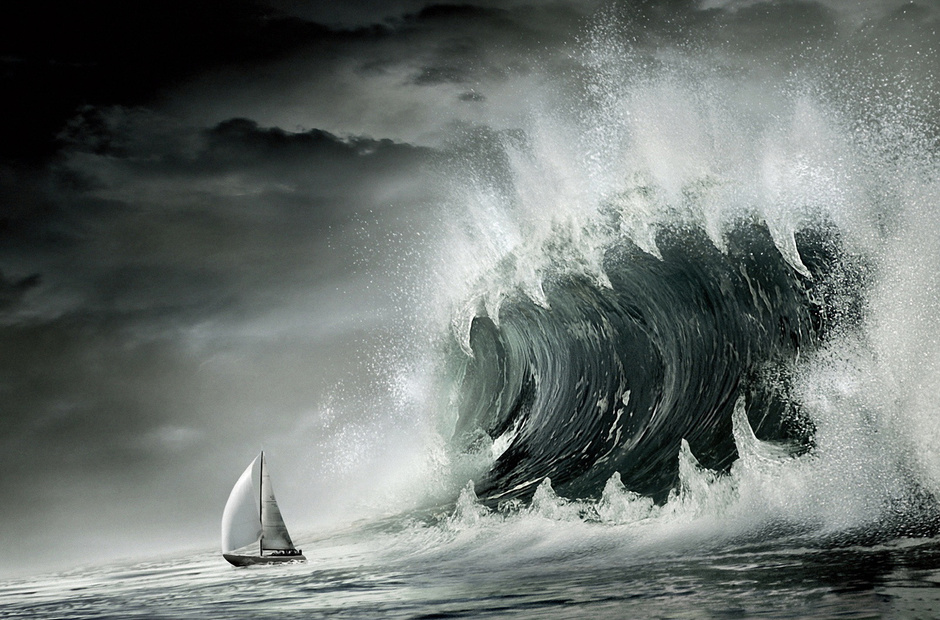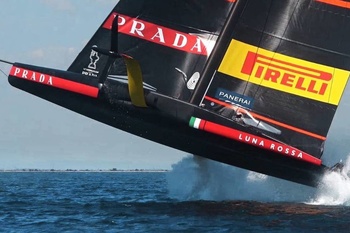«The impact was a terrible force: probably something like this is felt by a person sitting on the rails when he is hit by a train. And then everything around was immediately filled with water»," says Joy Carey, who had been dozing off in the cabin of her 45-foot Kelaerin, the first moments after meeting the killer wave. Her husband, Jim, was in the cockpit while driving the boat. On June 17, 2018, the couple were returning from a voyage through Hawaii. There were no more than 200 miles to the California coast, but...
This huge waterfall was never seen by Jim; rather, he had a purely physical sense of approach. A moment later, the boat took off on the huge berm, the crest of which then collapsed on deck, almost overturning the Kelaerin. The mast remained in place by some miracle, but the VHF antenna was flushed off its top. The inflatable dinghy and rescue flesh had disappeared, the cockpit was flooded with water above the knee and the central saloon looked like it had been after the bomb exploded. And it all happened in seconds! Then there were almost four hours of desperate attempts to pump out the water and put into operation a backup transmitter, and in the finale - a miraculous rescue with a coast guard helicopter. By the way, the abandoned Kelaerin survived the stormy sea and a month later was found by a patrol boat almost 400 miles away and returned to its owners.
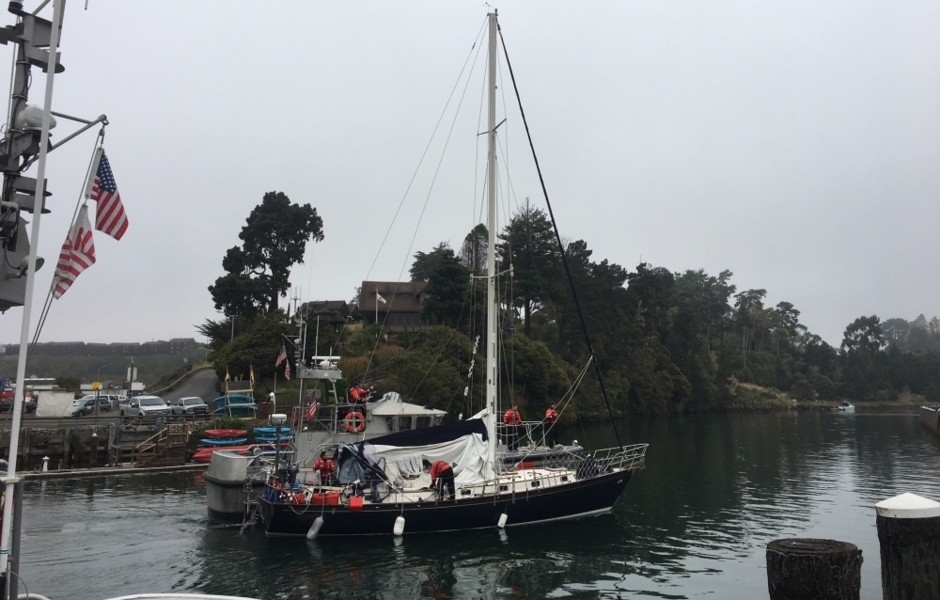
but when you get to know a «crazy» wave, this happy ending seems more like an exception to the rules.
For example, in February 2017, a 60-foot Clyde Challenger 220 miles from the Azores lost its mast and was flooded almost across the top deck. The four crew members were flushed overboard and survived a few unpleasant minutes before being pulled back in. Then 14 people on a semi-submerged boat waited for 20 hours for a British destroyer to break through the storm to help them.
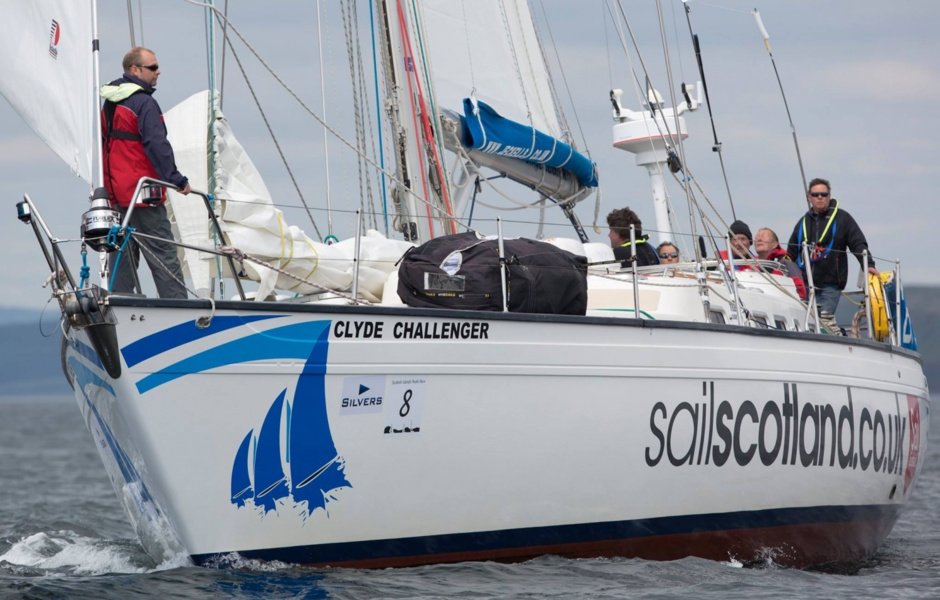
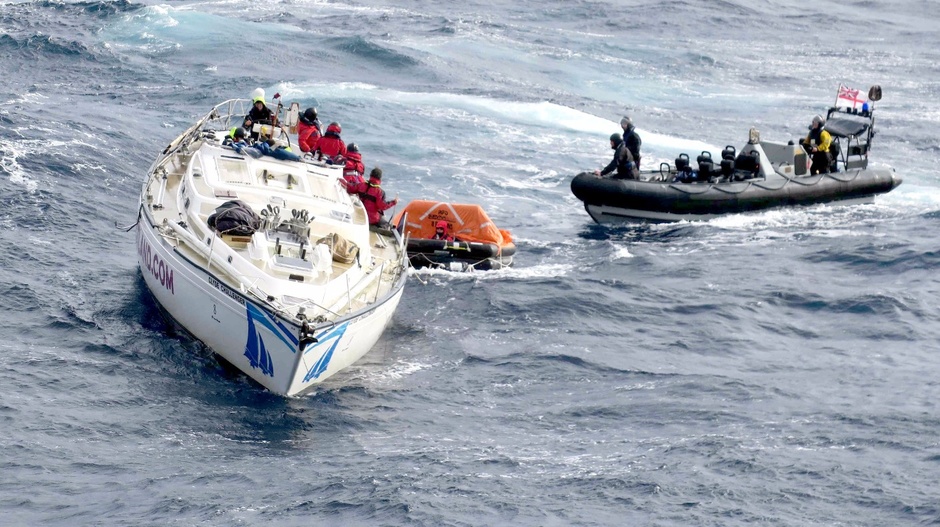
And in April 2012, a giant wave hit the 38-foot Low Speed Chase near San Francisco Bay. The result was one person killed on the spot, four others were flushed overboard and missing.
This mysterious phenomenon has many epithets and names: wandering, white, robber wave, crazy wave, monster wave... and the witty French call it just a «bad joke».
But there's no need to laugh - meeting such a wave poses a deadly threat to both relatively small yachts and the most modern «unsinkable» container or supertankers.
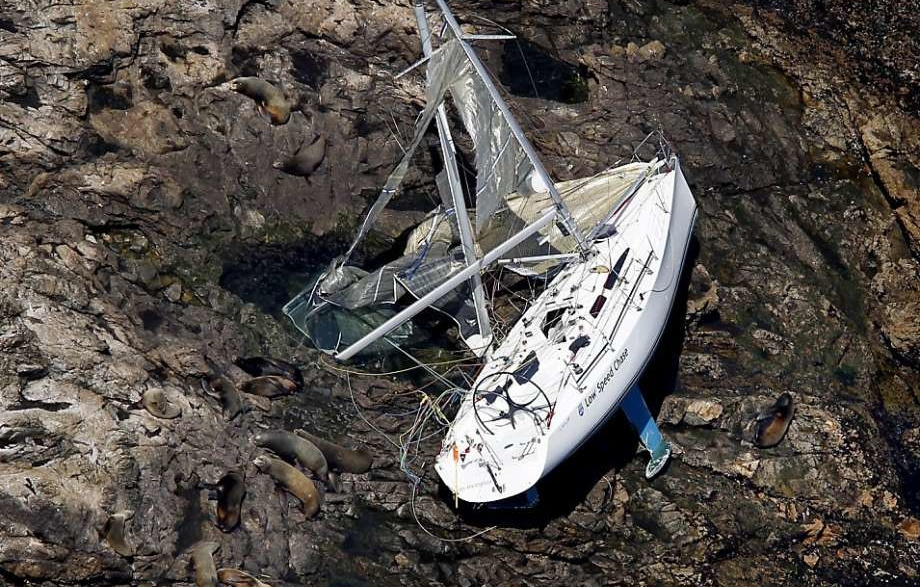
From myth to object of study
Apparently, the first sailor, who managed not only to meet the stray wave, but also to leave notes about his impressions after that, was Christopher Columbus. This happened during the third transoceanic voyage of the famous sailor - in August 1498. A squadron of six caravels in the moderate wind was moving along the southern tip of the island of Trinidad to the entrance to the Gulf of Paria, when suddenly heard a terrible roar, and as if out of nowhere there was a giant wave, quickly catching up with the ships. According to eyewitnesses' estimates, the crest reached the tops of the flagship's masts, which allows us to determine quite accurately its height - 87 feet or about 27 meters.
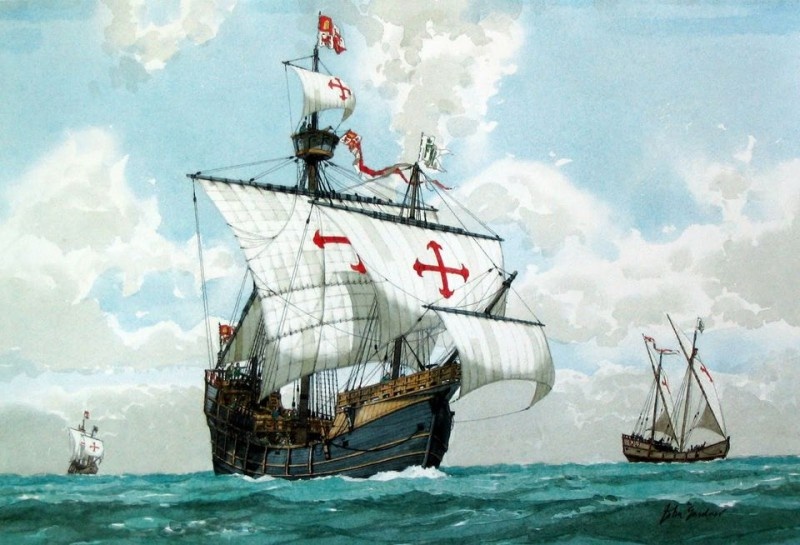
Fortunately, the Columbus sailors got away with a slight fright and a mass of acute experiences: none of the ships were damaged, and the flotilla continued its journey, exploring the coast of«Western India (»which, with subsequent careful consideration, turned out to be America).
Time went by, and sailing (including long-distance sailing) was more and more often undertaken not for pleasure, but for necessity. However, meeting the killer wave in the XIX century could sometimes turn a fascinating sailing cruise into an analogue of a horror movie. In May 1884, the 48-foot Mignonette, sailing from Southampton to Melbourne, was caught in a violent storm off the West African coast. Three days later, when the wind was almost gone, the boat was suddenly covered by a 12-meter wave. The captain and three crew members were in a four-meter boat about 800 miles from the nearest land. On the 19th day of the drift without food or water, the captain stabbed 17-year-old young Richard Parker to try to save himself and his remaining companions from starvation. In a way, they were lucky: five more days later, the forced ogres were saved by an accidentally passing passenger ship.
The mass arrival of steamers on ocean routes only expanded the list of stray wave victims.
Thus, on August 27, 1905 the bulk carrier Peconic, which was going from Philadelphia to New Orleans with the cargo of coal, collided with the 20-meter wave. The moment of impact coincided with the turn of the ship and led to the displacement of the cargo and rapid sinking of the transport. Of the 22 crew members, only two sailors were lucky enough to escape.
The tanker Ramapo was much luckier: on February 7, 1933, during the passage in the North Pacific Ocean, a wall of water 112 feet high (almost 34 meters) fell on it, but by some miracle the ship survived. By the way, the relatively precise height of the waterfall was determined by the fact that it flooded the «crow's nest» - an observation post on the mast.
Nevertheless, up to the middle of XX century messages about the killer waves were mostly perceived as skeptical, and their giant size preferred to be considered as a figment of imagination of the surviving witnesses (usually few).
However, in December 1942, witnesses of a meeting with a 75-foot (about 23 meters) wave turned out at once ... 15 thousand American soldiers, plus the entire crew of the English liner Queen Mary, on which the division of U.S. ground forces was moved from New York to Southampton.
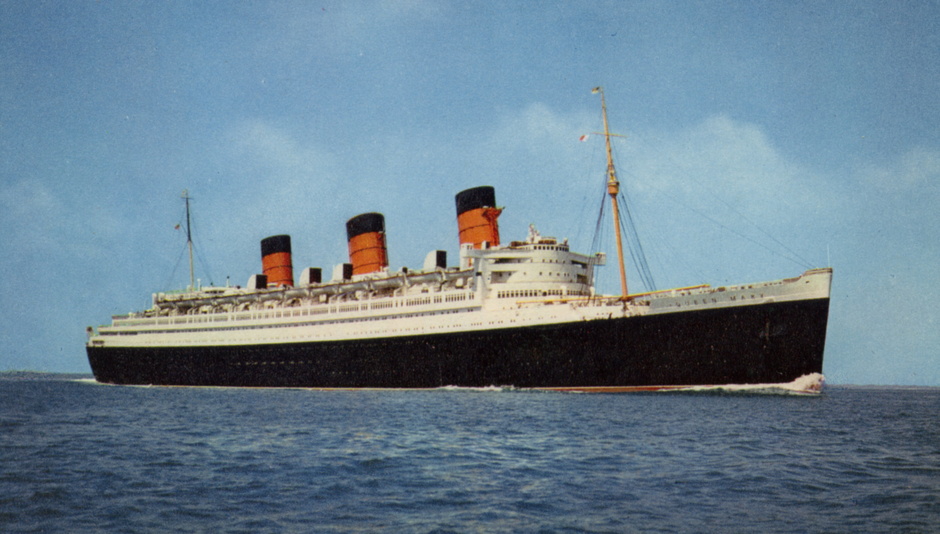
The impact was so strong that a huge passenger steamer (310 metres long and 81,000 tonnes of displacement) leaned 52 degrees. As technical experts subsequently calculated, an increase of three more degrees of inclination would have inevitably resulted in the ship's death.
In the post-war period, the threat of rogue waves began to be taken more seriously, especially as they themselves became increasingly visible. Thus, in the summer of 1966 in the Atlantic Ocean, a 21-meter wave attacked the Italian cruise liner Michaelangelo, breaking windows in the wheelhouse and two cabins of the first class. Two passengers and one crew member were killed in the attack. And on June 3, 1984, after collision with a stray wave near Bermuda in just 45 seconds (!) the three-masted Brigantina Marques sank, and only nine sailors from 28 on board managed to survive.
However, the first detailed «portrait of the» killer wave was not available until January 1, 1995.
On New Year's Eve, a hurricane raged in the North Sea, so the waves around the Draupner drilling platform (Statoil operator) periodically reached an 11-meter height. Suddenly, a real water mountain 25.6 meters high rose against their backdrop! This data was obtained with the help of a high-precision laser meter mounted on the platform, which inevitably attracted the attention of not only the media, but also scientists. As a result, the next quarter of a century has become a period of intense study of the nature of stray waves, necessary for their emergence conditions, as well as opportunities for reliable prediction of their appearance.
The entire Royal House
The first international seminar on giant wandering waves was held in Brest, France, in 2000 and has been held annually since then. In December of the same year, a special MaxWave project was launched in the European Union, which provides for a real hunt for killer waves with the participation of research ships, autonomous drifting beacons and satellite surveillance and telemetry systems. Already in the first three weeks MaxWave experts, together with specialists from the European Space Agency ESA, discovered in various areas of the world's oceans more than a dozen waves with a height of more than 25 meters. In this case, the British oceanographic vessel Discovery off the coast of Scotland was recorded wave of 95.5 feet (29.1 meters), as well as several 18.5-meter.
In 2012, researchers at the Australian National University were able to simulate the formation of a killer wave in a laboratory environment.
A «giant» wave created in a pilot basin turned over and sank a large-scale model of a large cargo ship. And in October 2017 in Oxford, it was possible to recreate in miniature the wave, which was recorded by Draupner platform instruments.
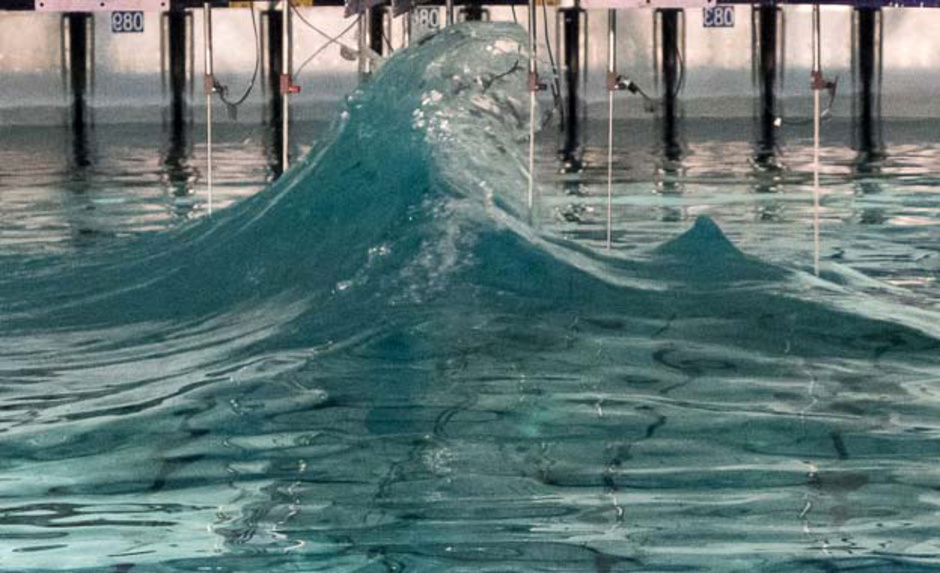
The network of stationary observation stations for areas of possible giant wave formation, which are equipped with the most modern equipment, is also continuously expanding. For example, in December 2017 a special Ekofisk measuring complex was launched on one of ConocoPhillips' drilling rigs in the central part of the North Sea. The devices installed on it allow scientists not only to measure the wave height with high accuracy (± 10 cm), but also to obtain a 3D-image of the wave in real time.
Curiously, the larger the research becomes (and thus the amount of money invested in it increases), the more victims are attributed to the killer waves, whose very existence was questioned relatively recently.
According to ESA specialists, it was the stray waves that caused the death of almost 200 large tankers and container ships, which have disappeared into the sea without a trace over the past twenty years.
It would seem that with such a serious concentration of forces, means and modern technology, most of the mysteries of the killer waves should already be solved, but ...
There are fewer answers than questions...
First of all, it turned out that there are several types of such waves at once. The first is a classic single wave, which suddenly appears even in a relatively calm sea, strikes and disappears just as rapidly. The second - three consecutive giant waves (so-called «three sisters), the»average of which has the highest height. Finally, single monster waves can also occur within 1-3 days after the end of violent storms. By the way, equally dangerous are the holes «in the ocean -» the unusually deep hollows between the two waves of average value.
Failing in such «a hole with its» bow or stern, the ship can burrow into the water column and instantly sink, and being at its ends on two adjacent ridges at the same time, it can break in two. The depth of a «sea hole» like this can be seen in the case of the English light cruiser Birmingham, which hit it in the fall of 1944 in the Pacific: on the upper bridge of the warship (18 meters above sea level!) Water climbed on his knee.

So, scientists followed the sailors to see that the killer waves and killer failures do exist.
Their unifying features are: significant size from the sole to the crest (15-35 meters), a strong hum at the time of appearance, high speed (80-100 kilometers per hour), as well as a short life span - from 20-40 seconds to 1-2 minutes. As for the rest of their properties, there are questions to which experts have not yet been able to give unambiguous answers.
So how do stray waves come about?
One of the main versions is that the surface streams of constant sea currents collide with a counter wind wave. This phenomenon is usually observed where the oceans meet - at Cape Horn and Cape of Good Hope. It is no coincidence that wandering waves are often also called keyprolers (from the English caperoller - enveloping capes). Areas of cold and warm currents are also at risk, so the probability of encountering a killer wave appears to be quite high near the Labrador Peninsula, on the approaches to the Gulf of Guinea, east of Japan and off the southeast coast of Australia.
But how do we explain the appearance of wandering water mountains in relatively closed water areas such as the Gulf of Mexico, the North and Mediterranean Seas or the Great Lakes?
The adherents of classical wave theory prefer to explain this phenomenon using the interference mechanism. Its essence consists in the superposition of waves, in which from a few relatively small waves is formed one giant. Sceptics note, however, that in this case the killer waves should meet much less frequently than it happens in practice and is documented by satellite images. Linear addition of sizes and amplitudes alone is not enough for this, which means that we can talk about a kind of «energy vampireism». Proponents of this version claim that under certain external conditions sea waves acquire the ability to exchange kinetic energy.
«The vampire» wave gradually sucks energy out of its neighbors, which can lead to a sharp (and unexpected for an outside observer) increase in its size.
After reaching critical height, the «vampire» instantly resets the accumulated energy, which explains two features of the wandering wave - the force of impact and a short period of its visible to the human eye of existence.
Another group of researchers is trying to combine the study of linear and nonlinear wave properties with an in-depth analysis of environmental features. In doing so, they highlight the following necessary conditions that are highly likely to lead to the formation of a stray wave:
- The presence of a close area of low pressure.
- Sharp changes in wind direction and speed.
- Movement of waves in overlapping directions (thickening).
- Topographical features of the shore or underwater relief that contribute to changes in wave direction.
- The presence of a series of ten so-called effective waves, the height of which is 20-30% higher than the average in the area.
- The special shape of the wave crest and its change.
It should be noted that all the above «discoveries» turn out to be common risk factors in a storm (or pre-storm) sea when viewed carefully. For the most part, they have long been known to yacht captains, but unfortunately do not add to understanding of the nature of the stray wave.
Is it possible to predict the appearance of a killer wave?
Industry research provides a rather evasive answer to this question. Even satellite photos show quite accurately where water monsters are born, but only after they have already been born. In principle, scientists believe it is possible to predict the occurrence of giant waves, but do not guarantee that sailors will be able to effectively use such information. Indeed, if the active life time of a killer wave is only a few tens of seconds, then how much time will be left to maneuver after it is detected? It is no coincidence that one of the experts on stray waves, Professor Steinmeier from the Max Born Institute (Berlin), noted with humor that the most accurate tool for tracking them has long been invented and available to everyone. It is called a window (on a drilling platform) or a window (on a ship), but the main thing is to look at it in time.
However, where theorists are forced to cover their powerlessness with Humor, practitioners usually come to the aid.
An example would be the observations of American yachtsman Rupert Holmes. In October 2015, his 36-foot Zest met a «crazy» wave 130 miles northwest of the Spanish port of La Coruña, losing a piece of sheathing at the bow measuring about 1.9m x 0.6m and a mast that was broken a few meters above deck.
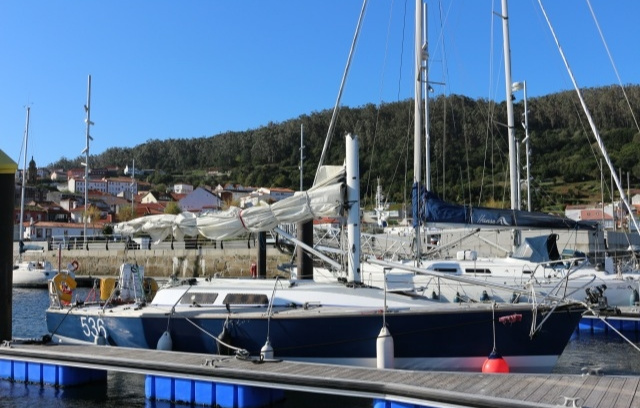
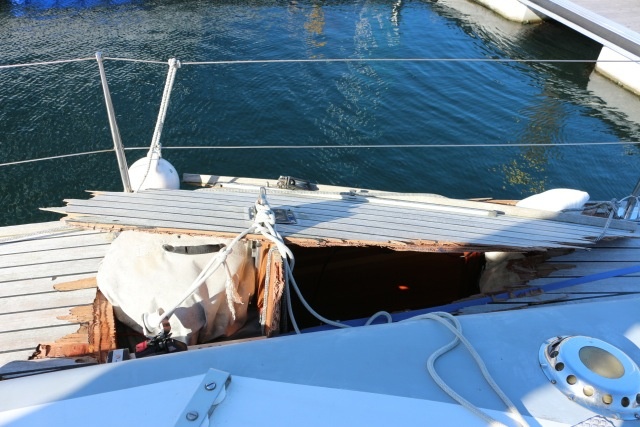
At the time of the collision, Rupert and his companion were below deck, so they could not see the wave itself. Everything was as usual in such cases: suddenly a terrible buzzing sound was heard and immediately a strong blow followed. Later, analyzing what had happened together with experts of the European Centre of Medium Term Weather Forecasts (ECMWF) Holmes came to curious conclusions. According to archived data of meteorological observations, significant wave height (i.e. arithmetic mean of 30% of the largest waves observed in 20 minutes) reached four meters at the point of the incident. This practically means that there is a high probability that seven-metre waves will also occur at that point. However, given the expansion of the area and the length of the observation period taken to calculate significant heights, almost 14-meter giants could theoretically be among the normal waves. Note that 150 miles west of the Zest site at the same time a significant wave height of 5.5 meters, which created the real prerequisites for the emergence of 19-meter waves. Thus, a thorough analysis of the current meteorological data, taking into account their values in previous years, it would be logical to assume that a killer wave may appear in the area. On the other hand, it is difficult to carry out such studies directly on a yacht, and the accuracy of such a forecast (both in terms of coordinates of the place and time of birth of the giant killer) still leaves much to be desired. And yet, sailing enthusiasts can really reduce the risk of meeting an unwelcome guest. At the same time they won't have to spend all their free time solving systems of non-linear Schroedinger equations and other mathematical exercises. Instead, it seems appropriate:
- Thoroughly study the area of future voyages, including the risk factors of stray waves.
- Closely observe changes in the meteorological environment.
- Properly understand and analyze meteorological forecast data from coastal stations.
By the way, experts of meteorological services pay special attention to the last point, commenting periodic complaints of yachtsmen about inconsistency of forecasts and real situation at sea. In particular, coastal meteorologists strongly recommend to focus on the possible maximum height of the so-called combined waves, taking into account both the wind wave itself and the zybium. It is noteworthy that some industry experts (e.g. from New Zealand's Metservice) widely use the word combination rogue wave as a synonym for «combined waves».
As for the actual altitudes that can be reached by waves connecting wind energy with oceanic zybium, they are available in ready-made tables known from the basic courses of meteorology.
Horizontal - the height of wind waves; vertical - the height of zybies in feet.
| 5 | 6 | 7 | 8 | 9 | 10 | 11 | 12 | 13 | 14 | 15 | 16 | 17 | 18 | 19 | 20 | |
| 5 | 7 | 8 | 9 | 9 | 10 | 11 | 12 | 13 | 14 | 15 | 16 | 17 | 18 | 19 | 20 | 21 |
| 6 | 8 | 8 | 9 | 10 | 11 | 12 | 13 | 13 | 14 | 15 | 16 | 17 | 18 | 19 | 20 | 21 |
| 7 | 9 | 9 | 10 | 11 | 11 | 12 | 13 | 14 | 15 | 16 | 17 | 17 | 18 | 19 | 20 | 21 |
| 8 | 9 | 10 | 11 | 11 | 12 | 13 | 14 | 14 | 15 | 16 | 17 | 18 | 19 | 20 | 21 | 22 |
| 9 | 10 | 11 | 11 | 12 | 13 | 13 | 14 | 15 | 16 | 17 | 17 | 18 | 19 | 20 | 21 | 22 |
| 10 | 11 | 12 | 12 | 13 | 13 | 14 | 15 | 16 | 16 | 17 | 17 | 18 | 19 | 20 | 21 | 22 |
| 11 | 12 | 13 | 13 | 14 | 14 | 15 | 16 | 16 | 17 | 18 | 19 | 19 | 20 | 21 | 22 | 23 |
| 12 | 13 | 13 | 14 | 14 | 15 | 16 | 16 | 17 | 17 | 18 | 19 | 20 | 21 | 22 | 22 | 23 |
| 13 | 14 | 14 | 15 | 15 | 16 | 16 | 17 | 18 | 18 | 19 | 20 | 21 | 21 | 22 | 23 | 24 |
| 14 | 15 | 15 | 16 | 16 | 17 | 17 | 18 | 18 | 19 | 20 | 21 | 21 | 22 | 23 | 23 | 24 |
| 15 | 16 | 16 | 17 | 17 | 17 | 18 | 18 | 19 | 20 | 21 | 21 | 22 | 23 | 23 | 23 | 25 |
| 16 | 17 | 17 | 17 | 18 | 18 | 19 | 19 | 20 | 20 | 21 | 21 | 22 | 23 | 24 | 25 | 26 |
| 17 | 18 | 18 | 18 | 19 | 19 | 20 | 20 | 21 | 21 | 22 | 23 | 23 | 24 | 25 | 25 | 26 |
| 18 | 19 | 19 | 19 | 20 | 20 | 21 | 21 | 22 | 22 | 23 | 23 | 24 | 25 | 25 | 26 | 27 |
| 19 | 20 | 20 | 20 | 21 | 21 | 21 | 22 | 22 | 23 | 23 | 23 | 25 | 25 | 26 | 27 | 28 |
| 20 | 21 | 21 | 21 | 22 | 22 | 22 | 23 | 23 | 24 | 24 | 25 | 26 | 26 | 27 | 28 | 28 |
| 21 | 22 | 22 | 22 | 22 | 23 | 23 | 24 | 24 | 25 | 25 | 26 | 26 | 27 | 28 | 28 | 29 |
| 22 | 23 | 23 | 23 | 23 | 24 | 24 | 25 | 25 | 26 | 26 | 27 | 27 | 28 | 28 | 29 | 30 |
| 23 | 24 | 24 | 24 | 24 | 25 | 25 | 25 | 26 | 26 | 27 | 27 | 28 | 29 | 29 | 30 | 30 |
| 24 | 25 | 25 | 25 | 25 | 26 | 26 | 26 | 27 | 27 | 28 | 28 | 29 | 29 | 30 | 31 | 31 |
| 25 | 25 | 26 | 26 | 26 | 27 | 27 | 27 | 28 | 28 | 29 | 29 | 30 | 30 | 31 | 31 | 32 |
As can be seen in their tables, the relatively safe range of weather conditions is rather small (highlighted in green). The combination of already two-three meters of zybium and wind waves can generate a single water shaft, which collapsed on the Zest (highlighted in blue). As we move to the red sector of the table, the expected total wave is steadily approaching the ten-meter mark. If such level reaches significant heights of waves, then not far and before the appearance of giants, like that hung over the masts of the caravel of Columbus - and without any mysticism ...

